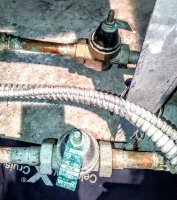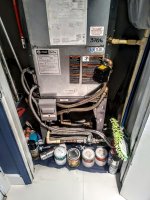Patrick D Garez
New Member
Hi to all,
Our hot water valve regulator is failing (deduced because cold water pressure is fine, however, the further I go towards the hot water side of our shower, faucets, washing mashing the pressure drops dramatically. All of our water release mechanisms are the temperature blend type, not separate hot and cold water).
I live (own) on the 37th floor of a condo. Building was built within the last 20 years or so.
We purchased the condo from the original owner who had installed water regulators (building maintenance confirmed that these were not installed at the point of construction or by the building which therefore removes their responsibility to maintain or repair).
Prior to the failing valve, the water pressure was already a little too low (livable but not ideal), so I am thinking of removing the failing valve all together (or if possible adjusting the failing valve so that it is essentially in the completely open position [not sure if this is an option].
I am aware that water regulators not only serve to reduce water (cost savings) but also to reduce pressure, coming in from city lines, that might be high enough to erode the plumbing system, over time.
Isn't the pressure already reduced because my water has to travel up (or down if we have a tower) from or to the 37th floor. As such would I not be risking very little by simply removing the valve and replacing it with a straight pipe? Is there a way to keep the valve in place and simply "opening" the valve up in such a way as to eliminate all restriction?
I am not a master DIY'er but having owned a house prior to the condo, I did handle some mundane DIY tasks in order to save a little cash, so can work my way around a small project like this (especially because the valves are easily accessible.)
Any help and advice that you might be able to offer would be greatly appreciated.
Thank you, all, very much in advance.
Patrick
Our hot water valve regulator is failing (deduced because cold water pressure is fine, however, the further I go towards the hot water side of our shower, faucets, washing mashing the pressure drops dramatically. All of our water release mechanisms are the temperature blend type, not separate hot and cold water).
I live (own) on the 37th floor of a condo. Building was built within the last 20 years or so.
We purchased the condo from the original owner who had installed water regulators (building maintenance confirmed that these were not installed at the point of construction or by the building which therefore removes their responsibility to maintain or repair).
Prior to the failing valve, the water pressure was already a little too low (livable but not ideal), so I am thinking of removing the failing valve all together (or if possible adjusting the failing valve so that it is essentially in the completely open position [not sure if this is an option].
I am aware that water regulators not only serve to reduce water (cost savings) but also to reduce pressure, coming in from city lines, that might be high enough to erode the plumbing system, over time.
Isn't the pressure already reduced because my water has to travel up (or down if we have a tower) from or to the 37th floor. As such would I not be risking very little by simply removing the valve and replacing it with a straight pipe? Is there a way to keep the valve in place and simply "opening" the valve up in such a way as to eliminate all restriction?
I am not a master DIY'er but having owned a house prior to the condo, I did handle some mundane DIY tasks in order to save a little cash, so can work my way around a small project like this (especially because the valves are easily accessible.)
Any help and advice that you might be able to offer would be greatly appreciated.
Thank you, all, very much in advance.
Patrick


